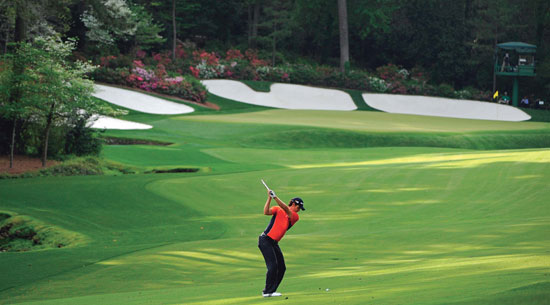Nearly every golf course in North America, Asia and Continental Europe has been rated for handicapping purposes using the USGA Course Rating and Slope Rating system that I developed more than 30 years ago. Notably, all but a handful of the courses among Golf Digest's list of America's 100 Greatest have been rated officially by authorized regional and state golf associations. So it seems curious that the No. 1-ranked course, Augusta National Golf Club, doesn't have an official USGA rating.
The reason? Despite the fact that almost every member has a USGA Handicap Index from another club, Augusta National maintains its system for members only.
As Golf Digest Contributing Editor David Owen wrote in his book, The Making of the Masters, the system developed by co-founder Clifford Roberts is based on the number of pars a player ordinarily makes in a round, with a small adjustment for birdies. If you average six pars per round, for example, your handicap would be 12. (Think of it as 18 holes minus six pars equals a handicap of 12.) The club also uses Roberts' method for allocating handicap strokes, using yardage as the criterion.
Consequently, Augusta National has, for decades, forbidden the Georgia State Golf Association from rating the course. In 1990, I assisted the late Ross Goodner, then a Senior Editor at Golf Digest, in putting together a team of USGA Course Rating experts to surreptitiously rate the course during the Masters. Then-chairman Hord Hardin wouldn't allow it to be done officially. "Our members already know each other's games," Hardin said.
"This was like telling Edmund Hillary he couldn't try to climb Everest," Goodner wrote in April 1991, when he reported the first unofficial Course Rating of the championship course: 76.2. That put Augusta National among the top-10 toughest courses in the United States.
Before last year's Masters, Golf Digest asked me to form a team to reassess the rating after the course had been lengthened more than 500 yards during multiple transformations over the past two decades. A rating team consists of four trained volunteers. I contacted the golf associations in and around Georgia, but they all held to the club's wishes that it not be rated, so I embarked as a team of one to determine an unofficial rating. Because I invented the rating system, taught golf associations worldwide how to use it and have rated more than 1,000 courses,
I could handle this assignment on my own, despite having to stay outside the ropes, as was the case in 1990. (Word of our plan had preceded my arrival.)
Tim Clark demonstrates why we rated Golden Bell as the most difficult hole for "recoverability" at Augusta.
I walked the course multiple times during three days of practice rounds, including following players and even walking the course in reverse from the 18th green to the first tee to capture the nuances. I measured landing areas by stepping off the crosswalks. I counted paces of the players walking on the greens to measure their width and depth. I estimated the green speed at 12 feet on the Stimpmeter, based on my experience at 25 U.S. Opens (16 in the employ of the USGA). Conditions change from day to day, of course, and Augusta National can be dramatically different later in the week.
COURSE RATING VERSUS SLOPE
USGA course rating is a measure of a course's difficulty level for a scratch golfer: someone who plays to a zero handicap on golf courses. It doesn't have any relationship to par: A short and easy par 72 could have a low Course Rating in the 60s, but a monster like the Ocean Course at Kiawah Island has a rating of 79.7 and a Slope Rating of 153 from the rarely used 7,873-yard tees (versus 77.3 and 144 from the regular back tees of 7,356 yards).
Slope Rating measures the relative difficulty of a course for Bogey Golfers and other players of "varying abilities" when compared with the Course Rating. Though there are no limits for a Course Rating -- the par-73, 8,325-yard Pines Course at The International in Bolton, Mass., has a Course Rating of 80.0 -- Slope Ratings range from 55 to 155. Standard playing difficulty is 113. The TPC Sawgrass Stadium Course has a Slope Rating of 155 from the back tees because it's extremely difficult for Bogey Golfers when compared to the already high 76.8 Course Rating for scratch players.
When Golf Digest ranked America's 50 Toughest Courses in March 2007,the Ocean Course led the list with the highest combination of Course Rating and Slope in America, according to the USGA. Years ago I visited Ko'olau Golf Club in Hawaii and estimated its Slope at 162, but since then many diabolical areas just off the fairways have been cleaned up, and the slope is listed at 152. Another point of reference: Before the 2008 U.S. Open, the Southern California Golf Association measured Torrey Pines' South Course under U.S. Open yardage and assigned a Course Rating of 79.7 and a Slope of 152.
The USGA established a new definition of scratch when I developed the system in 1975-'78, basing it on U.S. Amateur players from the time who averaged 250-yard drives (for men). The Yardage Rating Formula is still based on that standard because changes to how players overcome distance would require constant re-ratings of thousands of courses. The best amateurs today hit the ball a lot farther than they did 30-plus years ago and have Handicap Indexes of plus-3 or plus-4 (better than scratch). The PGA Tour professionals are at least at plus-5, and Tiger Woods was measured as a plus-10 during his amazing year of 2000.
RATING AUGUSTA NATIONAL
Following the USGA formula for rating courses, I graded each hole at Augusta National for 10 obstacle factors on a scale of 0 to 10. The rating criteria:
1. Topography. Difficulty of stance in the landing area and the vertical angle of shots to the green from the landing area. The par-4 11th, with a downhill stance and long downhill second shot, gets the highest rating, a 7.
2. Fairway. The effective target size of the landing area with the hole length factored. The 465-yard 18th, with a full dogleg right that squeezes the landing area between large fairway bunkers to the left and trees to the right, also gets a 7 rating.
3. Recoverability and rough. The par-3 12th rates highest with a 6. No U.S. Open rough at Augusta National keeps this rating category from being in the Open range of 7s to 9s.
4. Out-of-bounds. Out-of-bounds or extreme rough near the landing area and green. Nothing higher than a 2.
5. Water hazards. Difficulty of this hazard as it comes into play. The par-5 13th is an 8 with water running along the left, forcing drives toward the right trees. For those going for the green in two, there is a very difficult crossing stream that catches shots coming up short, and the green slopes toward the water and is squeezed by bunkers in the back.
6. Trees. Strategic location of trees, size and height, and their effect on drives and approach shots. The 18th leads with a 7.
7. Bunkers. Location, size, depth of bunkers relative to landing area and green target difficulty. The 18th again rates highest with a 7. The fairway bunkers on the left are forced into play by the dogleg and right-side trees. The approach from the deep fairway bunkers is a very difficult uphill shot, and the greenside bunkers are deep and strategically placed.
8. Green target. Getting onto greens in regulation, affected by the size, firmness and shape of a green in relation to the length of the approach shot. A tie with 8s for the 10th, 11th, 12th, 13th and 18th holes. The greens have multiple small target areas depending on the hole placement, with difficult approach shots.
9. Green surface. The slope, contour and speed of the green. This is one of the most notable features of the course during the Masters. Holes 1, 10, 11, 14, 15, 16, 17 and 18 all qualify as 9s with difficult hole placements, high contours and swift Stimpmeter speeds.
10. Psychological. The mental effect on score created by very difficult obstacles near the target areas. Holes 1 and 18 are both 8s. The starting hole and the finishing hole always qualify for some values, but both of these par 4s have a collection of highly rated obstacles, giving an overall mental impact.
The most difficult holes, when evaluated by just their "obstacle difficulty," also were the most difficult to par in the 2009 Masters: the 505-yard, par-4 11th; the 155-yard 12th; the 495-yard, par-4 10th and the 18th.
1990 VERSUS TODAY
The course played at 6,905 yards in 1990. Twenty years later, it plays at 7,435, an increase of 530 yards but still at a par of 72. (Interesting side note: Because of the daily changes in tees and flagstick locations, Clifford Roberts believed in giving hole yardages in increments of five yards; to this day you don't see Augusta National list holes at 457 yards or 463 yards.)
Just including effective playing length from elevation, doglegs and roll, I estimated the yardage rating before last year's tournament at 74.7. All obstacle ratings of 0 to 10 go into a USGA formula that becomes a "scratch obstacle stroke value." In Augusta National's case, that produces a whopping 3.4 additional strokes, for an unofficial rating of 78.1 -- up from 76.2 in 1990 and still among the top 10 in the country.
Our group didn't estimate a Slope Rating 20 years ago, but I did this time. It's high at 137 but not off the charts. From today's championship tees most Bogey Golfers can't reach Augusta's long par 4s in regulation, but the fairways are relatively wide and the players can hit relatively short third shots into greens, minimizing many of the difficulty factors (water, bunkers, green targets, etc.). Laying up and then pitching a third shot to the par-4 11th, for example, might result in a two-putt 5 for the Bogey Golfer today; 20 years ago, when the hole was 50 yards shorter, Mr. Bogey might have been tempted to go for the green, bringing the water left of the green into play and turning himself into Mr. Triple Bogey.
Anthony Kim shows the dangers that
await those who miss the fairways on
Augusta's par 5's.
We've established that the Course Rating for a scratch player would be 78.1. A player with a 10.0 Handicap Index would have a course handicap of 12, with an average score of 93 (78.1 Course Rating, plus the course handicap of 12, plus 3, because golfers average three strokes over their handicap). A player with an 18.0 Handicap Index would have a course handicap of 22 and would average 103 strokes.
How did the 2009 Masters competitors score compared with the Course Rating? The best five amateurs in the world (by virtue of major amateur results) averaged 75.4, in line with their plus-3/plus-4 ability, and all missed the cut. The entire field of 96 averaged 72.6, which is an exceptional level of golf. Winner Angel Cabrera averaged plus-10 handicap golf with 20 birdies and a score of 12 under par.
Why wouldn't Augusta National want to share that information with the world? Or give the USGA Handicap System a try? Well, the National remains a very private place. And maybe, as Hord Hardin said, the important thing is that members still know each other's games.
Contributing Editor Dean Knuth was the USGA's Senior Director of Handicapping
for 16 years and invented the Course Rating and Slope system. Known as The Pope
of Slope, he taught the system throughout the world. His website is popeofslope.com.
 Justin Rose plays a classic risk-reward shot.
Justin Rose plays a classic risk-reward shot.




